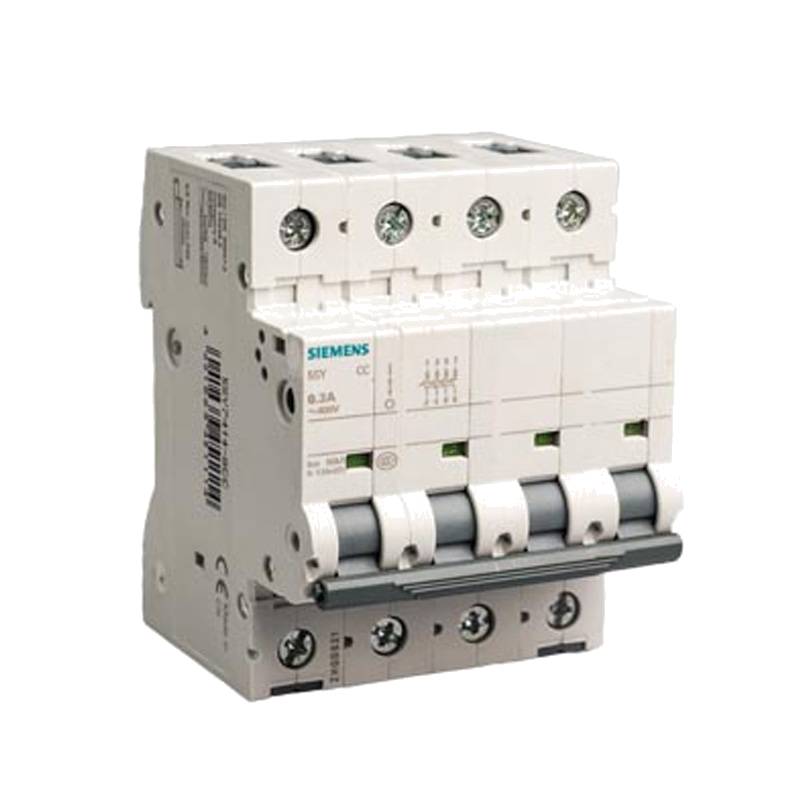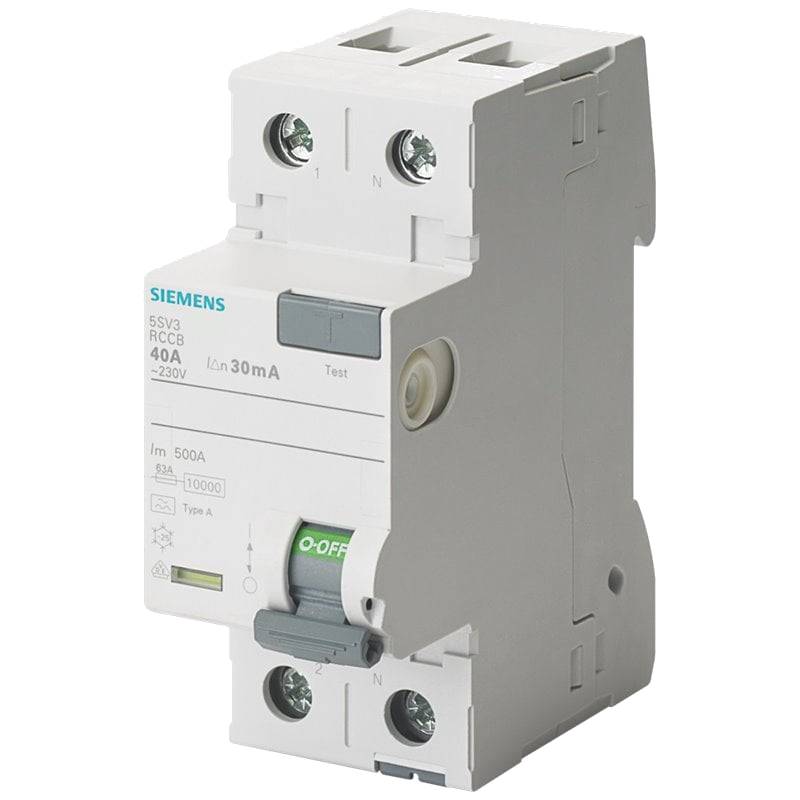
The Siemens 5SY6502-7CC is a highly reliable 1P+N 2A double-pole miniature circuit breaker (MCB) designed for robust electrical protection in demanding industrial and commercial applications. This MCB distinguishes itself through its rapid tripping mechanism, ensuring swift disconnection in fault conditions to safeguard sensitive equipment and prevent electrical hazards. Its compact design facilitates space-saving installations, while its high breaking capacity guarantees performance even under severe short-circuit events. With a nominal voltage of 230/400V AC and a tripping characteristic of C, the 5SY6502-7CC offers precise overcurrent and short-circuit protection, making it an essential component for reliable power distribution.
Siemens 5SY6502-7CC: Product Specifications
| Feature | Specification |
| :---------------------- | :------------------------------------------ |
| Product Type | Miniature Circuit Breaker (MCB) |
| Pole Configuration | Double Pole (1P+N) |
| Rated Current | 2A |
| Tripping Characteristic | Type C |
| Rated Voltage (AC) | 230/400V |
| Breaking Capacity (Icn) | 6 kA (at 230/400V AC) |
| Frequency | 50/60 Hz |
| Insulation Voltage (Ui) | 500V |
| Overvoltage Category | III |
| Protection Class | IP20 (terminal end) |
| Terminal Type | Screw Terminals |
| Mounting Type | DIN Rail (35mm) |
| Ambient Temperature | -25 to +45 °C |
| Standards | IEC/EN 60898-1, IEC/EN 60947-2 |
| Manufacturer | Siemens |
| Product Number | 5SY6502-7CC |
Core Features & Market Positioning
The Siemens 5SY6502-7CC leverages Siemens' renowned quality and engineering expertise, positioning it as a premium choice for critical circuit protection. Its Type C tripping curve is particularly advantageous, offering enhanced immunity to nuisance tripping caused by inrush currents common in inductive loads like motors and transformers, while still providing sensitive protection against short circuits. This makes it superior to Type B devices in many industrial settings. The MCB's robust construction and high breaking capacity of 6 kA ensure reliable operation even under fault conditions that could overwhelm lower-rated breakers. This reliability is a key differentiator in environments where downtime is costly.
Key Application Scenarios
This Siemens MCB finds extensive use in protecting individual circuits within electrical distribution boards for industrial machinery, control panels, and commercial building power systems. It is ideal for safeguarding circuits with moderate inrush currents, such as those powering small motors, fluorescent lighting ballasts, and small transformers. Applications include protecting lighting circuits, socket outlets for office equipment, and specific sub-circuits in manufacturing plants where precise and dependable overcurrent protection is paramount. Its compact 1P+N design is efficient for single-phase circuits requiring neutral conductor protection.
Practical System Integration Guidance
Integrating the Siemens 5SY6502-7CC into existing electrical infrastructure is straightforward due to its standard 35mm DIN rail mounting and readily accessible screw terminals. Ensure the incoming line conductors are connected to the appropriate terminals, typically line to the top and neutral to the bottom, or vice versa depending on local wiring conventions and safety requirements. Similarly, outgoing conductors for the load should be connected to the corresponding output terminals. Proper torque must be applied to the screw terminals to ensure a secure connection and prevent overheating. It is crucial to verify that the circuit's anticipated load and potential fault currents do not exceed the MCB's rated specifications (2A and 6kA, respectively) to ensure correct operation and safety.
Operation and Risk Mitigation
The Siemens 5SY6502-7CC operates by detecting overcurrents (both overloads and short circuits) and automatically interrupting the flow of electricity to prevent damage to connected equipment and wiring, as well as mitigating fire risks. Its thermal element responds to sustained overloads, while the magnetic element provides rapid response to short circuits. Users should be aware that the "C" curve is designed for loads with higher inrush currents; selecting the incorrect curve can lead to either nuisance tripping or inadequate protection. Regular visual inspection for any signs of damage or overheating is recommended. In the event of repeated tripping, a thorough investigation of the circuit load and potential faults is necessary before resetting the breaker.
Scalability & Long-Term Value
The 5SY6502-7CC embodies Siemens' commitment to backward and forward compatibility within their extensive electrical component ecosystem. While this specific MCB is a foundational protective device, its integration into larger Siemens electrical distribution systems allows for seamless expansion. This means that as power requirements or system complexity grows, users can confidently integrate additional Siemens circuit breakers, surge protective devices, and other components, knowing they will work harmoniously. This interoperability ensures long-term value by protecting investments in existing infrastructure while enabling future upgrades and the adoption of smart grid technologies or IIoT solutions that may require enhanced monitoring and control capabilities offered by more advanced Siemens products.
Frequently Asked Questions (FAQs)
What is the primary function of the Siemens 5SY6502-7CC MCB?
This MCB acts as an automatic safety switch. It protects electrical circuits from damage caused by overcurrents. This includes both overloads and short circuits.
It trips the circuit quickly to prevent overheating and potential fires. The device ensures the integrity of the connected electrical system. It safeguards sensitive equipment.
The 5SY6502-7CC is specifically designed for reliable operation. It provides peace of mind for industrial and commercial installations.
Can the Siemens 5SY6502-7CC be used for DC circuits?
No, this MCB is strictly designed for AC circuits. Its specifications and tripping mechanisms are optimized for alternating current. Using it on DC circuits could lead to unpredictable performance.
It may fail to trip correctly or at all. This poses a significant safety risk. Always ensure the breaker's rating matches the circuit type.
Refer to Siemens' DC circuit breaker offerings for direct current applications. These are engineered differently for DC system requirements.
What does the "C" in the tripping characteristic "Type C" mean?
"Type C" refers to the MCB's response to inrush currents. It's designed to tolerate higher temporary overcurrents. These occur when certain inductive loads, like motors, start up.
Compared to Type B breakers, Type C is less likely to trip unnecessarily during normal motor start-ups. However, it still provides rapid protection against short circuits.
This characteristic makes it suitable for applications with moderate inrush current scenarios. It balances protection with operational continuity.
How do I wire the Siemens 5SY6502-7CC double pole MCB?
Wire the incoming power supply to the top terminals. Connect the Line (L) conductor to one pole and the Neutral (N) conductor to the other. The outgoing circuit conductors connect to the corresponding bottom terminals.
Ensure the neutral pole is also protected by the breaker. This is crucial for safety in 1P+N configurations. Follow local electrical codes for specific wiring practices.
Always disconnect power before wiring. Use appropriate torque settings for the screw terminals to ensure a secure connection.
What is the breaking capacity (Icn) of the 5SY6502-7CC?
The Siemens 5SY6502-7CC has a breaking capacity of 6 kA. This rating is specified at its nominal voltage of 230/400V AC. It indicates the maximum fault current the breaker can safely interrupt.
A higher breaking capacity means the MCB can handle more severe short-circuit conditions without being destroyed. This is a critical safety feature. It ensures the breaker operates as intended during a fault.
This 6 kA rating is suitable for many industrial and commercial distribution systems. It provides robust protection against dangerous fault currents.
What is the recommended ambient operating temperature range for this MCB?
The recommended ambient operating temperature range for the Siemens 5SY6502-7CC is -25°C to +45°C. Operating outside this range can affect its performance and lifespan.
Temperatures above +45°C can lead to derating. This means the breaker may trip at a lower current than its rated 2A. Conversely, extreme cold can affect mechanical operation.
Ensure installations are in environments within these specified limits for optimal protection and longevity. Consider environmental factors in your design.
Can I replace a Siemens 5SY4 series MCB with the 5SY6 series?
Generally, you can replace an older Siemens 5SY4 series MCB with a 5SY6 series if the electrical specifications match. Both series share the same mounting dimensions and DIN rail compatibility.
However, always verify that the pole configuration (e.g., 1P+N), rated current (2A), voltage rating (230/400V AC), and tripping characteristic (Type C) are identical. There might be subtle differences in breaking capacity or other features.
Consult the datasheets for both series and local electrical codes. It's essential to ensure full compatibility for safety and performance.
What does 1P+N pole configuration mean?
1P+N signifies a double-pole circuit breaker. It simultaneously switches both the live (Line) conductor and the neutral conductor. This provides a higher level of safety than a single-pole breaker.
When the breaker trips, it completely isolates the circuit from the power supply. This is crucial for maintenance or during severe faults. It ensures both active conductors are de-energized.
This configuration is common in single-phase systems where neutral conductor switching is required by regulations or for enhanced safety. It is standard in many European installations.
How often should the Siemens 5SY6502-7CC be inspected?
Regular visual inspections are recommended, especially in harsh industrial environments. Look for signs of physical damage, discoloration, or signs of overheating on terminals.
Functional testing might be performed periodically according to site-specific safety protocols or regulatory requirements. This could involve manually operating the breaker to ensure the tripping mechanism engages.
The frequency of inspection should align with your facility's electrical maintenance schedule. More frequent checks may be warranted in dusty, humid, or vibration-prone locations.
What standards does the Siemens 5SY6502-7CC comply with?
This MCB complies with key international standards for circuit protection devices. It meets IEC/EN 60898-1, which covers domestic and similar electrical installations.
It also complies with IEC/EN 60947-2, the standard for low-voltage switchgear and controlgear. This ensures its suitability for industrial applications and demanding environments.
Adherence to these standards guarantees the product's quality, safety, and performance characteristics. It assures users of its reliability.

























